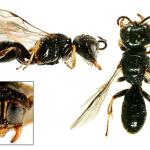Crossocerus aphidum LEPELETIER & BRULLÉ 1835
One of the smallest of a genus of small, predominately black, wasps. It seems to be genuinely scarce throughout its world range, but is very widespread. The female is very similar to that of Crossocerus wesmaeli, which can be abundant on light sands, but the male has a very distinctive peg on the underneath of the 7th antennal segment. For more comment on the separation of females see Edwards (1982).
Known from South-eastern England only:West Kent, Surrey and West Sussex. This species has not shown any great increase in range over the past twenty years, unlike many other species which are presumed to be highly thermophilic. However, a record made at Ambersham Common, a very well recorded site, in 2005 represents the first record for W. Sussex north of the Downs. Overseas, sporadic and rarely found, but distributed across central and southern Europe and Asia to Manchuria.
Listed as Rare (RDB 3) in Shirt (1987) and by Falk (1991).
These wasps may be found in open woodland (especially if regularly coppiced, including Chestnut coppice) and heath where the soil is light and sandy. The reference to chalk grassland in Falk (1991) appears to be a misrepresentation of the habitat at the Rewell Wood in Sussex, where tertiary sands and gravels give way to the north to chalk. The wasp is only ever found on the sands. Both sexes may be found sunning on the leaves of broadleaf trees in warm situations, however this is unlikely to relate to their prey requirements. The prey (see below) are often associated with grass stems, their larvae mining the stems. Female wasps can be found running up and down grass stems in sparsely-vegetated situations in the sun.
June to September. Probably continuous-brooded as fresh males can be found over much of this period.
All literature states that the prey of this wasp is unknown. However, as part of a study on this species based on a large population at the Rewell Wood I was able to excavate several nests. Only one contained prey items, all were chloropid flies (Diptera: Chloropidae), including the very common frit-fly Oscinella frit, which can be a pest of wheat. This observation has been mis-recorded as “dolichopodids and acalypterates” in Falk (1991).
Nest entrances are in the midst of loose sand and may have small tumuli if being currently excavated. The burrows are hockey-stick-shaped, with the brood-chamber in the lower, up-turned, part. They extend vertically down for about 2 cm and then level out for the last centimetre.
Apiaceae, especially hogweed, at Rewell Wood.
None known.
2009


